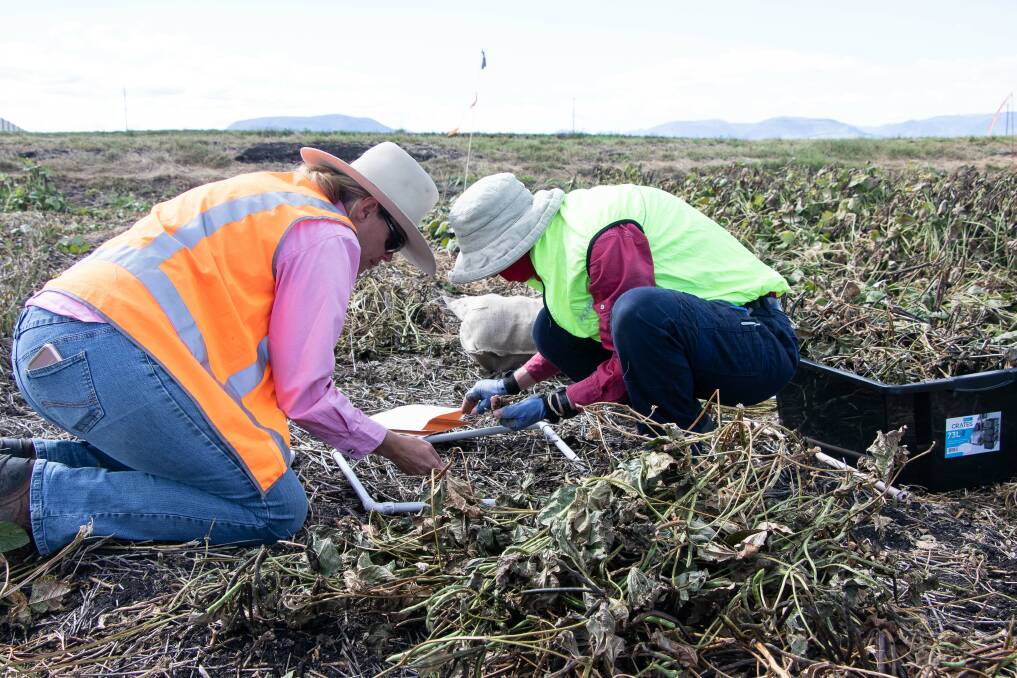
Mungbean growers have seized on research that's shown mechanical desiccation, such as swathing or windrowing, can be an effective alternative to chemical sprays.
Not only that, swathing mungbeans achieved faster dry down and more consistent seed quality than chemically desiccated crops in the trials.
Cameron Marsden, who grows mungbeans at Fernflat, north of Warra on the western Darling Downs, said he was highly skeptical at first, but has been convinced by what he's seen in two years of small plot and paddock scale trials.
"It's going to reduce our harvest losses from pod shatter and the other big thing is if you've got a week of fine weather, I wouldn't hesitate to do it again."
The research was prompted by industry concerns about hardening attitudes towards glyphosate, especially overseas where most of the Australian crop is sold for human consumption.
Department of Agriculture and Fisheries Queensland principal development extension officer Jayne Gentry, who leads the GRDC, DAF Qld and NSW DPI-funded mungbean agronomy project, said last year's trials followed tests by several growers.
"Every year we talk to industry about key limitations," Ms Gentry said.
"We were hearing from growers, agronomists, and most importantly, the Australian Mungbean Association, that chemically desiccating mungbeans especially newer, more vigorous high-yielding varieties was troublesome and they were keen to explore alternatives."
As an indeterminate plant without a defined flowering period, mungbeans can have flowers, green pods and black pods present at the same time.
This can make it difficult not only to decide when to harvest a crop, but to avoid sap staining the seed and causing quality and price downgrades.
For this reason, Australian farmers have used chemicals such as glyphosate and diquat to desiccate the crop - removing leafy material and drying the stems - in preparation for harvest.
In seasons like the past two years, when frequent rainfall events encouraged multiple flushes of pods, accurately determining the timing of chemical desiccation is complicated.
Spraying out crops with immature pods can result in translocation of glyphosate into the seed and detectable residues.
This can put consignments at risk of rejection for breaching MRLs and endanger access to key export markets where most Australian mung beans are sold for use in sprouting, cooking and processing.
Ms Gentry said last year's small plot replicated trials were carried out with the variety Jade-AU at Emerald, Warwick and Narrabri.
As well as comparing mechanical and chemical desiccation, they looked at the impact of timing of mechanical desiccation on plant moisture, grain yield, harvest losses and grain quality.
The plants were swathed with a hay cutter or hedge trimmer at 30 per cent, 60pc and 90pc physiological maturity, and compared to applying glyphosate or diquat at label rates at 90pc physiological maturity.
Five sets of biomass samples were taken between day three and 21 after cutting or spraying to measure dry down.
The swathed crops were dry enough to harvest without any impact on quality in about a week: half the time it took for the other crops to be ready.
"The clearest results that we got out of that small plot research was the change in dry down time and how much faster you can get into the paddock to harvest," Ms Gentry said.
"We also saw the grain quality in our mechanically desiccated mungbeans was far more consistent."
The results were enough to persuade growers between Warra and Gunnedah to sign up this year for 15 commercial scale trials in their own crops.
Researchers are still wading through that data, but Ms Gentry said mechanical desiccation again fared well against glyphosate-sprayed crops and growers were highly receptive to the idea.
"Because of the season, we were trying to hold back a tsunami of growers wanting to swath all their mungbeans," she said.
"They wanted to swath them so they could get them out of the paddock quicker as opposed to leaving them in the rain awaiting slower dry down under chemical desiccation."
A report on the trial results is due for release before the 2023 mungbean season.
In other news:
Mr Marsden, who also works as a contractor and has a self-propelled MacDon M155 windrower, cut and harvested many of the trial crops and said he'd learned a lot from it.
"After seeing how good a job it was doing, we did half a 600 acre paddock of our own," he said.
"It was coming into cooler weather, and it took seven to eight days (to dry down ready for harvest).
"With Roundup we've seen a few crops that have stretched out towards 16 to 20 days.
"It definitely brought it in a lot faster and we finished harvesting in early May before all this big rain that came through."
Mr Marsden said he thought the main obstacle to adoption would be access to pickup fronts for harvesting the windrowed beans.
"There's a bit of interest in it, but I think a lot of them would prefer to still do it with Roundup because they can do that themselves," he said.

